初中英语语法全解——介词(共21张PPT)
文档属性
| 名称 | 初中英语语法全解——介词(共21张PPT) |  | |
| 格式 | ppt | ||
| 文件大小 | 1.9MB | ||
| 资源类型 | 教案 | ||
| 版本资源 | 通用版 | ||
| 科目 | 英语 | ||
| 更新时间 | 2022-04-10 10:49:24 | ||
图片预览


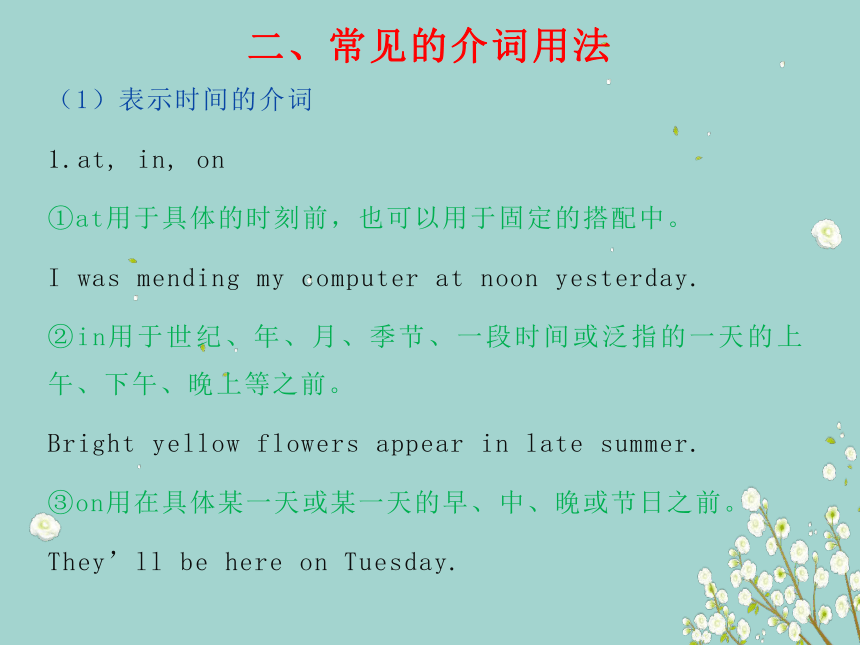
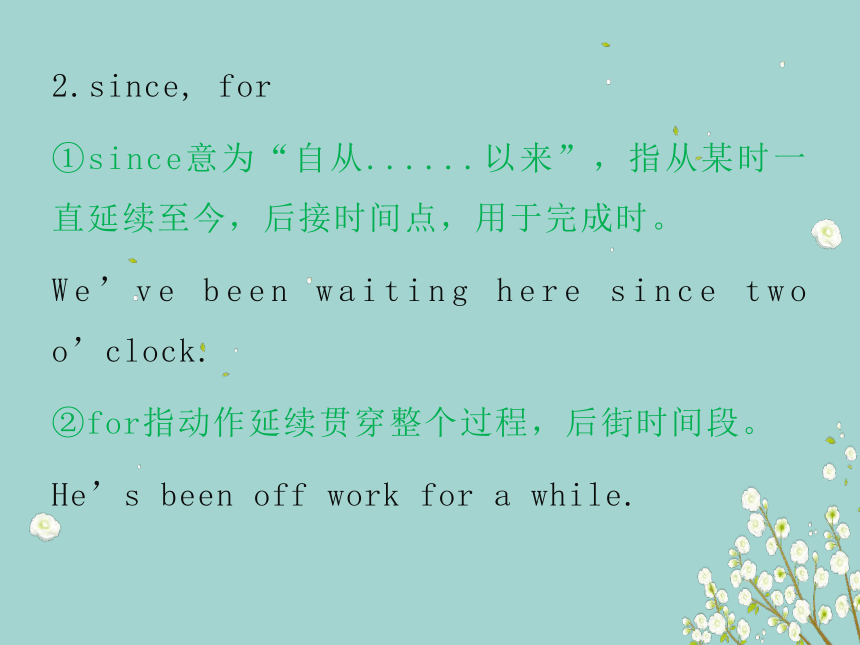
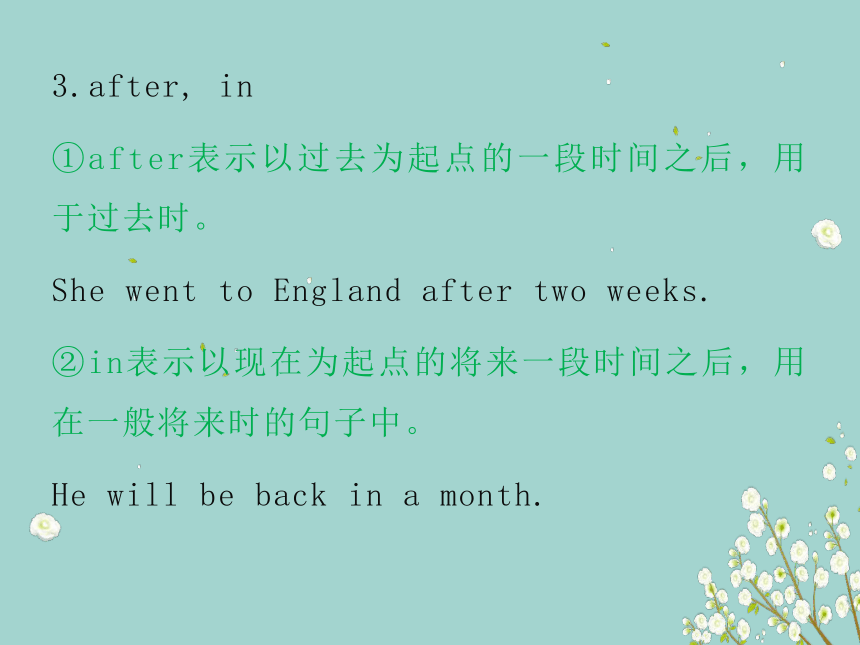
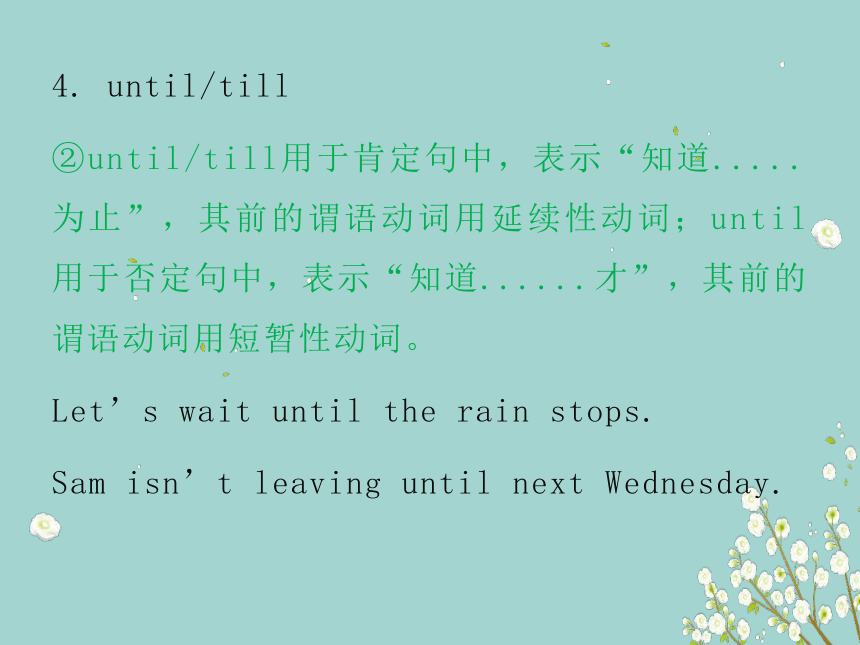

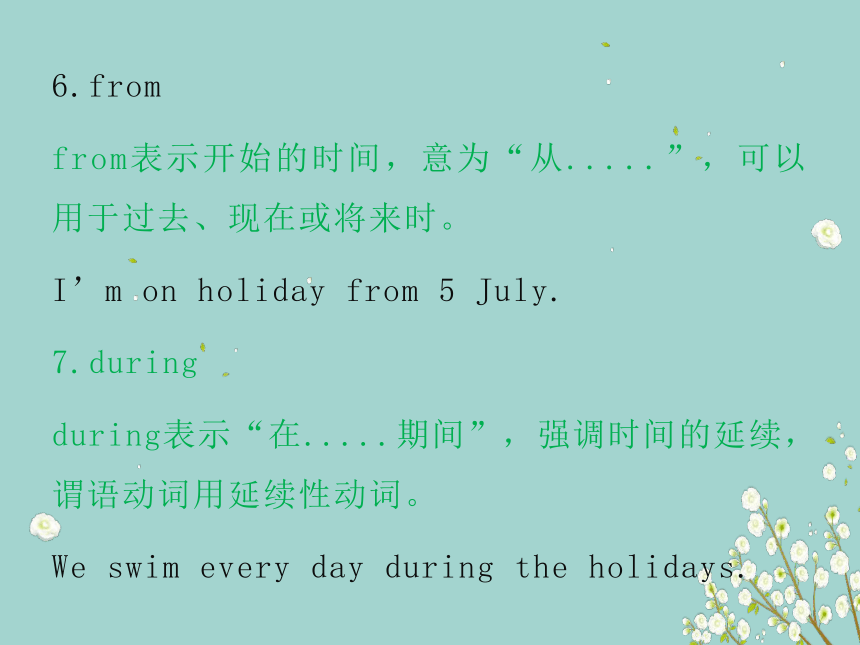
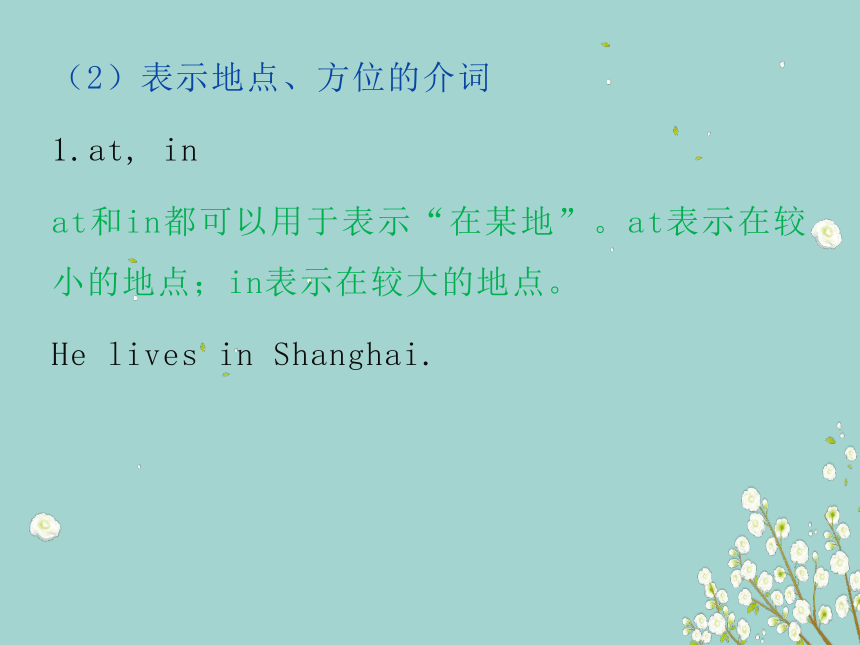
文档简介
(共21张PPT)
初中英语语法全解—介词
一、介词的定义
介词属于虚词。它是位于代词、名词或相当于名词的结构之前,表示其后的部分与句子其他成分的关系。介词在句中不能独立充当句子成分,通常不重读。
I’m really worried about Jack.
二、常见的介词用法
(1)表示时间的介词
1.at, in, on
①at用于具体的时刻前,也可以用于固定的搭配中。
I was mending my computer at noon yesterday.
②in用于世纪、年、月、季节、一段时间或泛指的一天的上午、下午、晚上等之前。
Bright yellow flowers appear in late summer.
③on用在具体某一天或某一天的早、中、晚或节日之前。
They’ll be here on Tuesday.
2.since, for
①since意为“自从......以来”,指从某时一直延续至今,后接时间点,用于完成时。
We’ve been waiting here since two o’clock.
②for指动作延续贯穿整个过程,后街时间段。
He’s been off work for a while.
3.after, in
①after表示以过去为起点的一段时间之后,用于过去时。
She went to England after two weeks.
②in表示以现在为起点的将来一段时间之后,用在一般将来时的句子中。
He will be back in a month.
4. until/till
②until/till用于肯定句中,表示“知道.....为止”,其前的谓语动词用延续性动词;until用于否定句中,表示“知道......才”,其前的谓语动词用短暂性动词。
Let’s wait until the rain stops.
Sam isn’t leaving until next Wednesday.
5.before, after
①before后接时间点,表示“在某个时间之前”。
Must I finish my homework before supper
②after后节时间点,表示“在某个时间之后”。
I go swimming every day after work.
6.from
from表示开始的时间,意为“从.....”,可以用于过去、现在或将来时。
I’m on holiday from 5 July.
7.during
during表示“在.....期间”,强调时间的延续,谓语动词用延续性动词。
We swim every day during the holidays.
(2)表示地点、方位的介词
1.at, in
at和in都可以用于表示“在某地”。at表示在较小的地点;in表示在较大的地点。
He lives in Shanghai.
2.in, on, to
in, on, to都可以用于表示方位。in表示在某一地区之内的某个方位,属于该范围;to表示某一地区之外的某个个方位,不属于该范围;on表示与某地相邻接壤。
Mexico is to the south of the US.
3.on, over, under, below
这一组介词都用于表示“在某物上、下位置”,但用法不同。on指与物体表面接触,即某物的表面上;over表示在某物的正上方,至垂直方向,它的反义词是under;above表示位置高于某物,在其上方,但不是正上方,它的反义词是below。
An airplane flew above our heads.
4.before, in front of, behind
这三个词表示“在某物的前/后位置”。before和in front of都表示在某物前面,可以互换;behind表示在某物后面。
Suddenly, something ran across the road in front of the car.
5.beside, by, near, nearby, next to, around
(1)beside和by都表示“在......旁边”,可以互换;near和nearby都表示“在附近”,可以互换。但by和beside比near和nearby更近。
She sat in a chair near the door.
(2)next to 表示“紧靠着,紧挨着”。
He placed his chair next to hers.
(3)around表示“环绕,在(......)周围”。
The whole family was sitting around the dinner table.
6.across, through, past, over, along, down
across表示从物体表面横穿;through表示穿过空间;past表示从某物的一旁经过;over表示从一边到另一边;along/down表示“沿着”。
John is going to swim across the river tomorrow.
She smiled at him as he walked through the door.
Walk down the road.
(3)表示方式、手段和工具的介词
in, by, with表示手段和工具
(1)in表示使用某种语言或使用某种材料,语言、材料名词前不用冠词。
What will you buy with the money
(2)by表示用某种方式手段,名词前不用冠词。
Her shoes were made by hand.
(3)with表示是哟用工具、手段等。
We can see with our eyes.
(4)其他介词
1.on,about
on, about都表示“关于”,但用法不同。on侧重于指比较重大或深奥的理论、学术等为恩替;about侧重于与人或事物有关的事迹或情况。
I have a book about fishing.
2.except,except for,besides
except, except for, besides都表示“除了”,但用法不同。except表示“除了......之外(其他的都......)”,其后的宾语被排除在整体之外;besides表示“除了......之外(其他的也......),其后的宾语被包括在整体里;except for表示“除了......之外”,它强调的是先肯定整体,然后从中排除一小部分,对整体内容起到修正作用。
Besides milk, we need some orange juice.
He loves his job except for the long hours.
3.between,among
between一般指两者之间;among一般指三者或三者以上之间。
He arrived between 9 and 10 last night.
4.of
of可以表示所属关系,也可以表示部分、范围等。
Here are two nice photos of my family.
5.like
like表示“像”。
Her hair is dark brown like mine.
6.with
with可以表示“和......一起”,也可以表示“带有”,还可以表示行为方式等。
She came back with a letter in her hand.
7.without
without表示“没有,无”。
He found the place without difficulty.
8.for
for可以表示目的,也可以表示原因。
I look after the kids for them.
9.as
as可以表示“像、按照”,也可以表示“作为”。
You ought to do as the teacher tells you.
10.against
against表示“反对”。
There are 10 votes for him and only 2 against him.
初中英语语法全解—介词
一、介词的定义
介词属于虚词。它是位于代词、名词或相当于名词的结构之前,表示其后的部分与句子其他成分的关系。介词在句中不能独立充当句子成分,通常不重读。
I’m really worried about Jack.
二、常见的介词用法
(1)表示时间的介词
1.at, in, on
①at用于具体的时刻前,也可以用于固定的搭配中。
I was mending my computer at noon yesterday.
②in用于世纪、年、月、季节、一段时间或泛指的一天的上午、下午、晚上等之前。
Bright yellow flowers appear in late summer.
③on用在具体某一天或某一天的早、中、晚或节日之前。
They’ll be here on Tuesday.
2.since, for
①since意为“自从......以来”,指从某时一直延续至今,后接时间点,用于完成时。
We’ve been waiting here since two o’clock.
②for指动作延续贯穿整个过程,后街时间段。
He’s been off work for a while.
3.after, in
①after表示以过去为起点的一段时间之后,用于过去时。
She went to England after two weeks.
②in表示以现在为起点的将来一段时间之后,用在一般将来时的句子中。
He will be back in a month.
4. until/till
②until/till用于肯定句中,表示“知道.....为止”,其前的谓语动词用延续性动词;until用于否定句中,表示“知道......才”,其前的谓语动词用短暂性动词。
Let’s wait until the rain stops.
Sam isn’t leaving until next Wednesday.
5.before, after
①before后接时间点,表示“在某个时间之前”。
Must I finish my homework before supper
②after后节时间点,表示“在某个时间之后”。
I go swimming every day after work.
6.from
from表示开始的时间,意为“从.....”,可以用于过去、现在或将来时。
I’m on holiday from 5 July.
7.during
during表示“在.....期间”,强调时间的延续,谓语动词用延续性动词。
We swim every day during the holidays.
(2)表示地点、方位的介词
1.at, in
at和in都可以用于表示“在某地”。at表示在较小的地点;in表示在较大的地点。
He lives in Shanghai.
2.in, on, to
in, on, to都可以用于表示方位。in表示在某一地区之内的某个方位,属于该范围;to表示某一地区之外的某个个方位,不属于该范围;on表示与某地相邻接壤。
Mexico is to the south of the US.
3.on, over, under, below
这一组介词都用于表示“在某物上、下位置”,但用法不同。on指与物体表面接触,即某物的表面上;over表示在某物的正上方,至垂直方向,它的反义词是under;above表示位置高于某物,在其上方,但不是正上方,它的反义词是below。
An airplane flew above our heads.
4.before, in front of, behind
这三个词表示“在某物的前/后位置”。before和in front of都表示在某物前面,可以互换;behind表示在某物后面。
Suddenly, something ran across the road in front of the car.
5.beside, by, near, nearby, next to, around
(1)beside和by都表示“在......旁边”,可以互换;near和nearby都表示“在附近”,可以互换。但by和beside比near和nearby更近。
She sat in a chair near the door.
(2)next to 表示“紧靠着,紧挨着”。
He placed his chair next to hers.
(3)around表示“环绕,在(......)周围”。
The whole family was sitting around the dinner table.
6.across, through, past, over, along, down
across表示从物体表面横穿;through表示穿过空间;past表示从某物的一旁经过;over表示从一边到另一边;along/down表示“沿着”。
John is going to swim across the river tomorrow.
She smiled at him as he walked through the door.
Walk down the road.
(3)表示方式、手段和工具的介词
in, by, with表示手段和工具
(1)in表示使用某种语言或使用某种材料,语言、材料名词前不用冠词。
What will you buy with the money
(2)by表示用某种方式手段,名词前不用冠词。
Her shoes were made by hand.
(3)with表示是哟用工具、手段等。
We can see with our eyes.
(4)其他介词
1.on,about
on, about都表示“关于”,但用法不同。on侧重于指比较重大或深奥的理论、学术等为恩替;about侧重于与人或事物有关的事迹或情况。
I have a book about fishing.
2.except,except for,besides
except, except for, besides都表示“除了”,但用法不同。except表示“除了......之外(其他的都......)”,其后的宾语被排除在整体之外;besides表示“除了......之外(其他的也......),其后的宾语被包括在整体里;except for表示“除了......之外”,它强调的是先肯定整体,然后从中排除一小部分,对整体内容起到修正作用。
Besides milk, we need some orange juice.
He loves his job except for the long hours.
3.between,among
between一般指两者之间;among一般指三者或三者以上之间。
He arrived between 9 and 10 last night.
4.of
of可以表示所属关系,也可以表示部分、范围等。
Here are two nice photos of my family.
5.like
like表示“像”。
Her hair is dark brown like mine.
6.with
with可以表示“和......一起”,也可以表示“带有”,还可以表示行为方式等。
She came back with a letter in her hand.
7.without
without表示“没有,无”。
He found the place without difficulty.
8.for
for可以表示目的,也可以表示原因。
I look after the kids for them.
9.as
as可以表示“像、按照”,也可以表示“作为”。
You ought to do as the teacher tells you.
10.against
against表示“反对”。
There are 10 votes for him and only 2 against him.
同课章节目录
- 词法
- 名词
- 动词和动词短语
- 动词语态
- 动词时态
- 助动词和情态动词
- 非谓语动词
- 冠词
- 代词
- 数词和量词
- 形容词副词及其比较等级
- 介词和介词短语
- 连词和感叹词
- 构词法
- 相似、相近词比较
- 句法
- 陈述句
- 一般疑问句和否定疑问句
- 特殊疑问句及选择疑问句
- 反意疑问句
- 存在句(There be句型)
- 宾语从句
- 定语从句
- 状语从句
- 主谓一致问题
- 简单句
- 并列句
- 复合句
- 主谓一致
- 主、表语从句
- 名词性从句
- 直接引语和间接引语
- 虚拟语气
- 感叹句
- 强调句
- 倒装句
- 祈使句
- 句子的成分
- 句子的分类
- 题型专区
- 单项选择部分
- 易错题
- 完形填空
- 阅读理解
- 词汇练习
- 听说训练
- 句型转换
- 补全对话
- 短文改错
- 翻译
- 书面表达
- 任务型阅读
- 语法填空
- 其他资料
